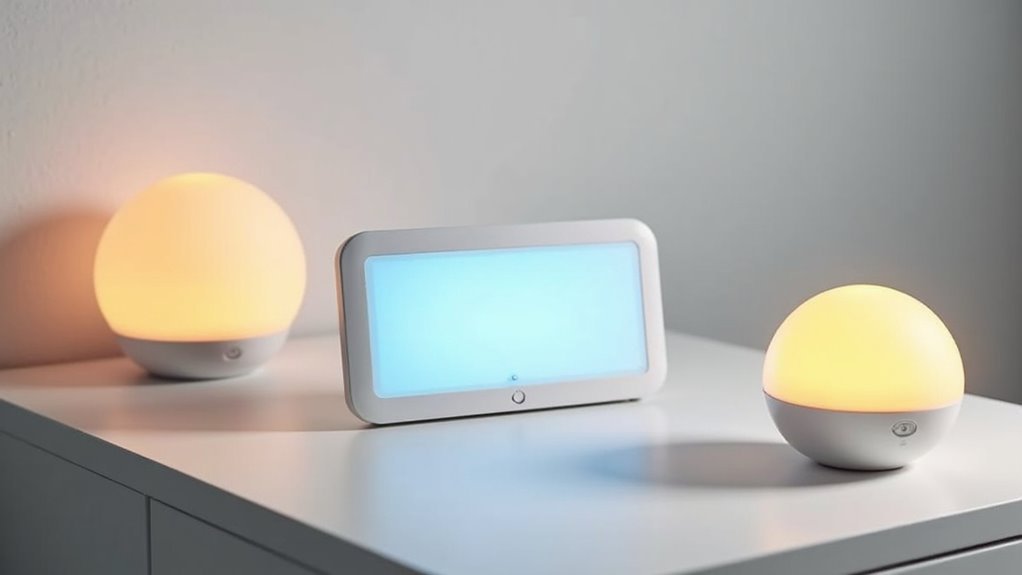You’ve probably noticed how many smart home systems send your location data to distant servers, creating privacy concerns you’d rather avoid. There’s a better approach that keeps everything local—using your own network infrastructure to detect who’s home without transmitting personal information beyond your walls. This method combines multiple detection technologies working together, but getting the setup right requires understanding which combination will work reliably in your specific environment.
Understanding Local Network-Based Detection Methods

Most home automation enthusiasts don’t realize they can achieve reliable presence detection without sending any data beyond their network perimeter.
Local network-based detection methods offer powerful alternatives to cloud-dependent solutions while maintaining complete privacy control.
Keep your presence detection data completely private by using local network methods instead of cloud-based tracking systems.
You can implement device trackers using ping sensors that send ICMP packets to check device connectivity. When your phone or laptop connects to your Wi-Fi network, these sensors detect their presence instantly.
However, some devices don’t respond to pings reliably.
Router-based detection provides a more dependable approach by querying your router directly for connected devices. Home Assistant supports numerous router integrations, letting you configure tracking based on your specific model.
Combining both ping sensors and router-based methods creates a robust system that minimizes false positives while keeping all data local.
Router Integration for Real-Time Presence Monitoring
You’ll find router integration offers the most reliable path to real-time presence monitoring by establishing direct connectivity with your network hardware.
Popular platforms like Unifi routers support dedicated integrations that let you create monitoring accounts with proper access permissions.
This approach transforms your router into a continuous device tracker that updates presence status instantly without depending on external services or unreliable ping methods.
Direct Router Connectivity
When you need faster and more reliable presence detection than traditional ping methods can provide, direct router connectivity offers a superior solution.
This approach allows you to monitor devices connected to your home network in real-time, markedly improving accuracy without depending on cloud services.
You’ll eliminate the polling lag and aging time issues that plague traditional ping methods, achieving quicker response times for your automation triggers.
Router-based presence detection operates entirely within your local network, protecting your privacy by keeping personal data away from cloud servers.
Popular router brands like Unifi, TP-Link, and Asus integrate seamlessly with Home Assistant, making configuration straightforward.
You’ll simply connect Home Assistant directly to your router’s API, creating a cleaner, more reliable presence detection system.
Supported Router Platforms
Home Assistant’s router integration capabilities span across several major networking platforms, each offering distinct advantages for presence monitoring.
You’ll find robust support for UniFi, TP-Link, and Asus routers, giving you flexibility in choosing hardware that fits your network setup.
UniFi systems provide enterprise-grade monitoring with detailed device insights, while TP-Link routers offer excellent consumer-friendly integration.
Asus routers bring advanced configuration options that enhance detection accuracy.
Each platform eliminates your dependence on individual device apps, creating a cleaner automation environment.
You can configure static DHCP leases across these platforms to maintain consistent IP addresses for known devices, greatly improving presence monitoring reliability.
This router integration approach reduces false positives and delivers faster response times compared to traditional ping-based detection methods.
Real-Time Device Tracking
Since router integration provides direct access to your network’s active device list, Home Assistant can instantly detect when devices connect or disconnect without relying on external cloud services.
This real-time device tracking eliminates the lag associated with polling methods, delivering immediate presence detection for responsive automations.
You’ll achieve cleaner detection by configuring static DHCP addresses for your devices, ensuring consistent IP assignments and reducing false positives.
This precision enables streamlined automations that adjust your home status instantly—modifying HVAC settings, lighting, and security systems based on actual occupancy.
For supported routers like Unifi, you’ll need to create a dedicated user account and link it to your Home Assistant instance.
This connection enables seamless device monitoring while maintaining complete privacy control within your local network.
GPS and Location Tracking Through Companion Apps
You can leverage GPS tracking through companion apps like Home Assistant to create precise zone-based automations that trigger when you enter or leave specific geographic areas.
However, you’ll need to balance location accuracy with battery consumption, as continuous GPS monitoring can considerably drain your device’s power.
Consider implementing smart polling intervals and geofence sizes that optimize both reliability and energy efficiency for your presence detection system.
Zone-Based Location Automation
While privacy concerns often make homeowners hesitant about location tracking, zone-based location automation through GPS and companion apps offers one of the most reliable methods for presence detection when configured properly.
Home Assistant’s companion app creates a device tracker that monitors your location without sending data to external clouds.
You can establish geofences around your home to trigger automations automatically:
- Set lights to turn on when you’re approaching home
- Adjust thermostats based on your proximity to specific zones
- Activate security systems when everyone leaves the defined area
- Combine multiple detection methods for enhanced accuracy
Android devices provide more consistent tracking than iOS, which may struggle with background app usage.
Enable background location services and verify GPS settings for ideal performance.
Battery Impact Considerations
Although GPS-based presence detection offers excellent accuracy, it comes with a considerable trade-off in battery consumption that you’ll need to contemplate carefully. The battery impact from continuous location tracking can reduce your device’s longevity by 20-30% when location services remain constantly active.
You’ll find that real-time tracking consumes notably more power than periodic updates or geofencing methods. On iOS devices, foreground app usage drains batteries faster than background operation.
To minimize this battery impact, you can optimize your companion app settings by reducing GPS check frequency or switching to WiFi-based location detection, which consumes less energy.
Smart companion apps offer battery optimization features that help balance tracking accuracy with power sustainability, letting you maintain reliable presence detection while preserving device performance.
Combining Multiple Detection Technologies for Accuracy

When you rely on a single detection method, false positives and missed detections become inevitable problems that can undermine your entire home automation system.
Combining WiFi and Bluetooth technologies creates a robust foundation for accurate presence detection, as WiFi identifies devices connected to your network while Bluetooth captures nearby devices that mightn’t be on your home network.
WiFi and Bluetooth work together to create comprehensive presence detection that captures both connected and nearby devices.
You’ll achieve ideal results by implementing these complementary technologies:
- Router-based detection with GPS tracking to eliminate individual method weaknesses
- Motion Sensors paired with front door sensors for physical entry verification
- Device charging status monitoring to understand usage patterns and likely presence
- Community-tested hybrid systems that blend multiple technologies without cloud dependencies
This multi-layered approach guarantees your privacy-first system delivers reliable presence detection while maintaining complete local control over your data.
Setting Up RFID and Bluetooth Beacon Systems
Once you’ve established your multi-layered detection foundation, RFID and Bluetooth beacon systems offer the most reliable hardware-based approach for privacy-first presence detection. You’ll want to configure ESP32 devices with Home Assistant integration for seamless BLE beacon deployment throughout your home.
| Component | Setup Requirements | Privacy Benefits |
|---|---|---|
| Active RFID Tags | Fixed readers, minimal interaction | No external data transmission |
| BLE Beacons | ESP32 devices, MQTT broker | Local network communication only |
| Home Assistant | Integration modules, automation rules | Complete local processing |
| Detection Zones | Strategic placement, signal mapping | Room-level presence detection |
Your RFID system requires active fobs for reliable communication with fixed readers, while Bluetooth beacons use BLE technology for real-time presence detection. This combination creates multiple verification points, ensuring accurate automation triggers while keeping all data within your local network infrastructure.
Configuring Home Assistant for Privacy-Focused Automation

Home Assistant becomes your central automation hub after implementing hardware-based detection systems, transforming raw presence data into intelligent, privacy-respecting actions.
You’ll configure device trackers that operate entirely within your local network, ensuring no personal information leaves your home.
Your privacy-focused presence detection setup requires these key configurations:
- Create static DHCP leases for tracked devices to maintain consistent IP addresses
- Configure ping sensors and router-based tracking methods that bypass cloud services
- Combine WiFi and Bluetooth detection methods for enhanced reliability and accuracy
- Link device trackers to person entities for seamless automated responses
Custom scripts can ping specific IP addresses to update presence status locally.
Home Assistant processes all data internally, enabling sophisticated automation scenarios like lighting adjustments and security responses without compromising your privacy or relying on external dependencies.
Troubleshooting Common Detection Challenges and Solutions
Three fundamental challenges plague privacy-first presence detection systems: false positives from device power-saving behaviors, connectivity inconsistencies that create phantom absences, and timing mismatches between different detection methods.
Privacy-first presence detection faces three core issues: device power-saving false positives, connectivity gaps, and detection method timing conflicts.
You’ll solve these by combining WiFi, Bluetooth, and motion detectors for enhanced accuracy and reliability.
Assign static IP addresses through DHCP to prevent tracking issues from changing IPs. Monitor device battery status since low power triggers sleep modes that block presence detection queries.
Implement backoff delays between ping attempts to accommodate devices in power-saving modes or experiencing connectivity issues.
Regularly verify your configurations, ensuring devices link properly to Home Assistant and settings align with your privacy preferences.
This multi-layered approach eliminates false readings while maintaining your privacy-first automation goals.
Frequently Asked Questions
How Much Does a Complete Privacy-First Presence Detection System Typically Cost?
You’ll typically spend $200-800 for a complete system. Basic setups with motion sensors cost around $200-300, while advanced systems featuring multiple sensors, smart hubs, and automation capabilities can reach $600-800.
Can Presence Detection Work During Power Outages or Internet Connectivity Issues?
You’ll lose presence detection during power outages unless you’ve got battery backup systems. Internet outages won’t affect local sensors, but you’ll lose remote notifications and cloud-dependent features completely.
Will Privacy-First Detection Systems Work With Existing Smart Home Devices and Ecosystems?
You’ll find compatibility varies considerably between privacy-first systems and existing smart home ecosystems. Many require specific protocols like Zigbee or Z-Wave, while others integrate through local hubs, bypassing cloud dependencies entirely.
How Often Should Detection Hardware Be Updated or Replaced for Optimal Performance?
You should replace detection hardware every 3-5 years for ideal performance. However, you’ll need updates more frequently if you’re experiencing connectivity issues, reduced accuracy, or when manufacturers stop providing security patches.
Are There Legal Considerations When Implementing Presence Detection in Rental Properties?
You must obtain written tenant consent before installing any monitoring systems. Check local landlord-tenant laws, as some jurisdictions prohibit surveillance in rental units. You’re also required to disclose detection systems in lease agreements.





Leave a Reply